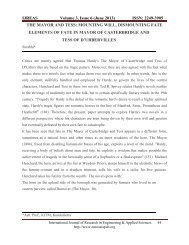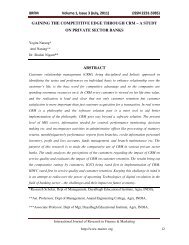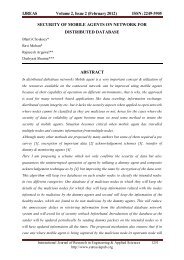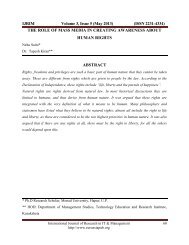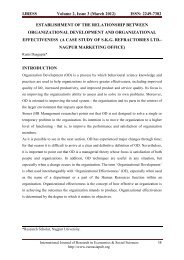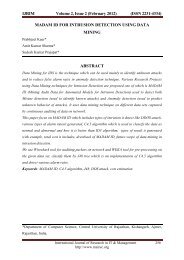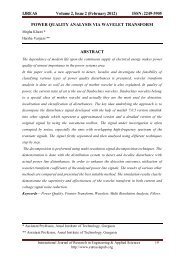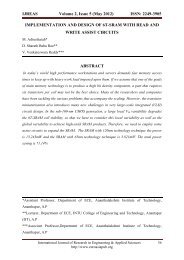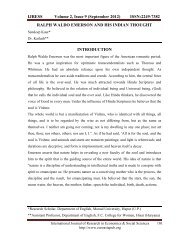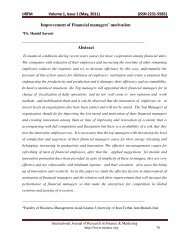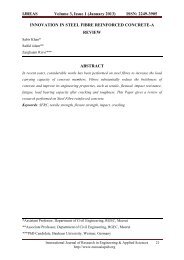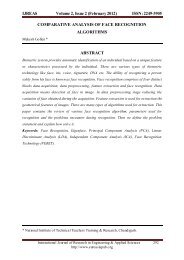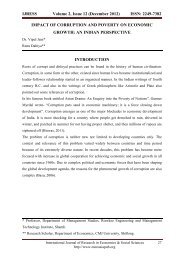scope of biodiesel in india - Euroasiapub.org
scope of biodiesel in india - Euroasiapub.org
scope of biodiesel in india - Euroasiapub.org
You also want an ePaper? Increase the reach of your titles
YUMPU automatically turns print PDFs into web optimized ePapers that Google loves.
IJREAS Volume 2, Issue 8 (August 2012) ISSN: 2249-3905<br />
compared to the amount that could be reached through cultivation on regular plantations,<br />
either through monoculture or <strong>in</strong>ter-cropp<strong>in</strong>g. These plantations can, <strong>in</strong> turn, be set up on<br />
three types <strong>of</strong> land: regular agricultural land, regular forestland as well as un- or underutilised<br />
land (<strong>of</strong>ten called “wasteland”). The first possibility, plantations on regular fertile agricultural<br />
lands, implies competition with other crops that can also be grown here. In India, most<br />
farmers are not will<strong>in</strong>g to plant oil-bear<strong>in</strong>g trees on fertile lands because yields and prices are<br />
considerably lower than those <strong>of</strong> food crops such as rice, wheat or sugar at this po<strong>in</strong>t <strong>in</strong> time.<br />
Chang<strong>in</strong>g cultivation patterns on already used fertile agricultural lands will only take place if<br />
the revenues from the cultivation <strong>of</strong> oil-bear<strong>in</strong>g trees exceed those from food crops, which<br />
would presuppose either considerably higher demand (e.g. through higher prices <strong>of</strong><br />
conventional fuel) or extraord<strong>in</strong>ary <strong>in</strong>creases <strong>in</strong> productivity The second possibility, to grow<br />
oil-bear<strong>in</strong>g trees on forest land, ma<strong>in</strong>ly refers to afforestation. Regenerat<strong>in</strong>g degraded forest<br />
areas for ecological reasons and susta<strong>in</strong>able use <strong>of</strong> resources is desired <strong>in</strong> many forest<br />
regions <strong>of</strong> India. Pongamia – like any other tree – can serve this purpose very well. Jatropha,<br />
<strong>in</strong> contrast, is a shrub rather than a tree and it is therefore less useful for afforestation. India<br />
strongly promotes jo<strong>in</strong>t forest management (JFM) programmes <strong>in</strong> order to comb<strong>in</strong>e the<br />
benefits <strong>of</strong> afforestation and <strong>in</strong>come generation for lower casts and tribal people . The third<br />
possibility – and the one most favoured <strong>in</strong> the public discussion <strong>in</strong> India – is the use <strong>of</strong> un- or<br />
underutilised land for cultivation <strong>of</strong> oil-bear<strong>in</strong>g trees. Such land that is not suitable for any<br />
other crop because <strong>of</strong> its low fertility is called “wasteland” <strong>in</strong> day-to-day parlance. The<br />
Wastelands Atlas <strong>of</strong> India, a satellite-based land survey by the Indian M<strong>in</strong>istry <strong>of</strong> Rural<br />
Development, identifies 553,000 km² <strong>of</strong> the 3.3 million km² <strong>of</strong> total land area <strong>in</strong> India as<br />
wasteland (MoRD 2005, 12). Considerable parts <strong>of</strong> India’s degraded forest land (108,000<br />
km²), land with scrub vegetation (151,000 km², ibid.) – together amount<strong>in</strong>g to more than 8 %<br />
<strong>of</strong> the total geographic area <strong>in</strong> India – as well as certa<strong>in</strong> other lands6 could serve for<br />
plantations <strong>of</strong> oil-bear<strong>in</strong>g trees. Although more recently, the Government <strong>of</strong> India reduced its<br />
estimate <strong>of</strong> land reserves that are suitable for bi<strong>of</strong>uel crop cultivation to 72,000 km², even this<br />
potential is enormous (Shankar 2006, 94). More drought-resistant than most other crops, oilbear<strong>in</strong>g<br />
trees can contribute to the rehabilitation <strong>of</strong> unutilised land by stabiliz<strong>in</strong>g soil,<br />
improv<strong>in</strong>g manure cover and br<strong>in</strong>g<strong>in</strong>g degraded land back <strong>in</strong>to productive use.<br />
However, the term wrongly suggests that all <strong>of</strong> this land lies waste and is not used by<br />
anybody. In reality, even unsuitable degraded land is still <strong>of</strong>ten used illegally by the poorest<br />
parts <strong>of</strong> the population for subsistence agricultural production or – even more commonly –<br />
for cattle husbandry. Claims <strong>of</strong> 13.4 million ha <strong>of</strong> available land for TBO cultivation<br />
International Journal <strong>of</strong> Research <strong>in</strong> Eng<strong>in</strong>eer<strong>in</strong>g & Applied Sciences 6<br />
http://www.euroasiapub.<strong>org</strong>



